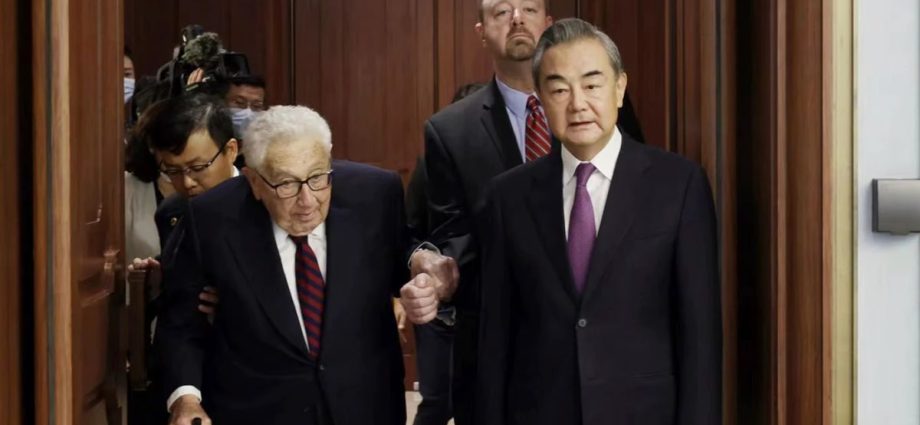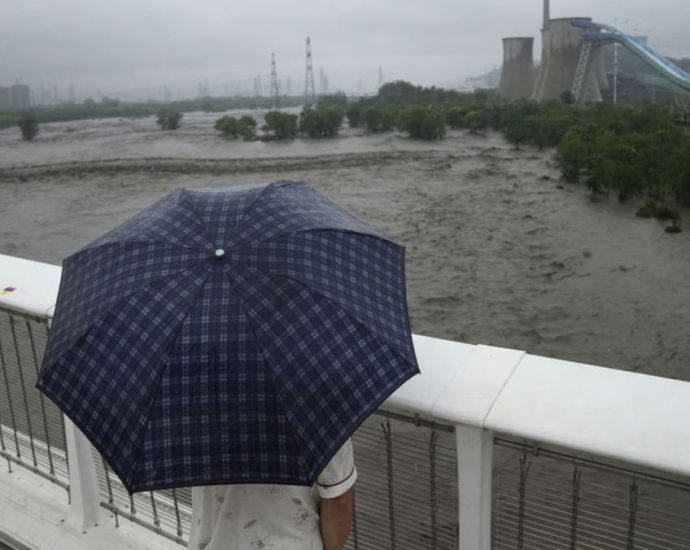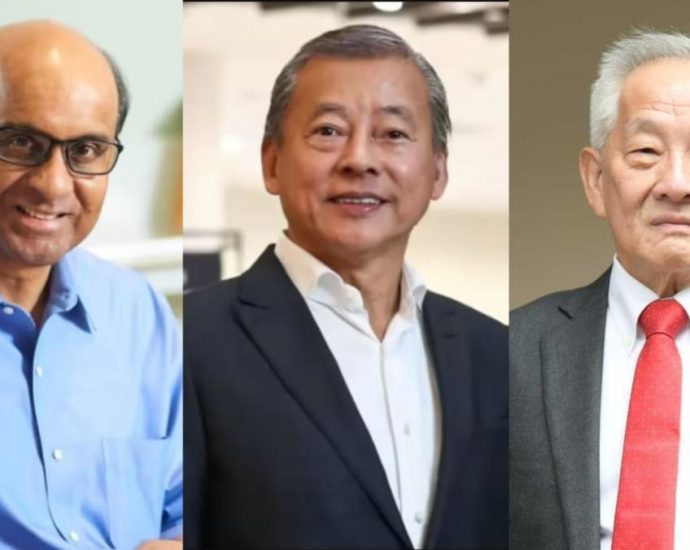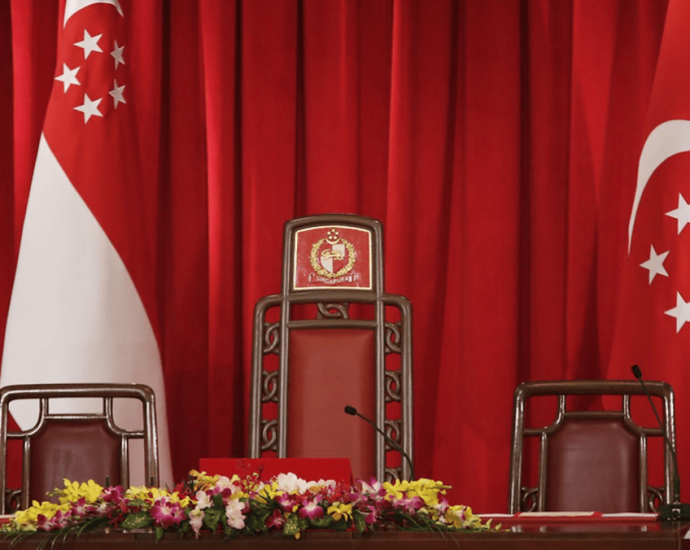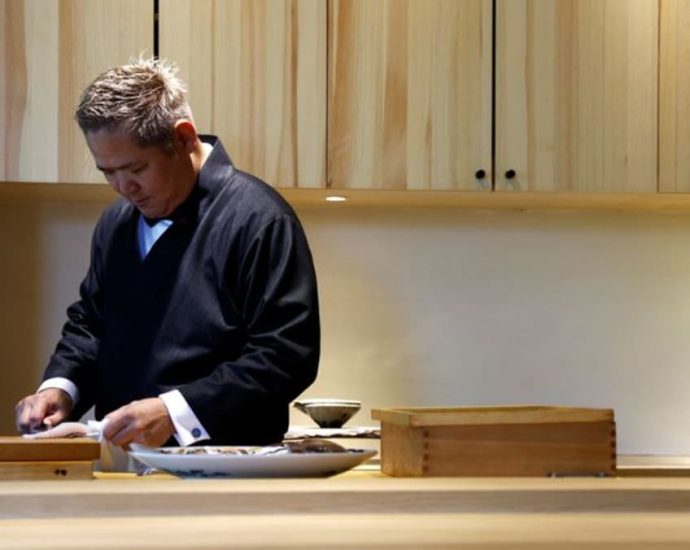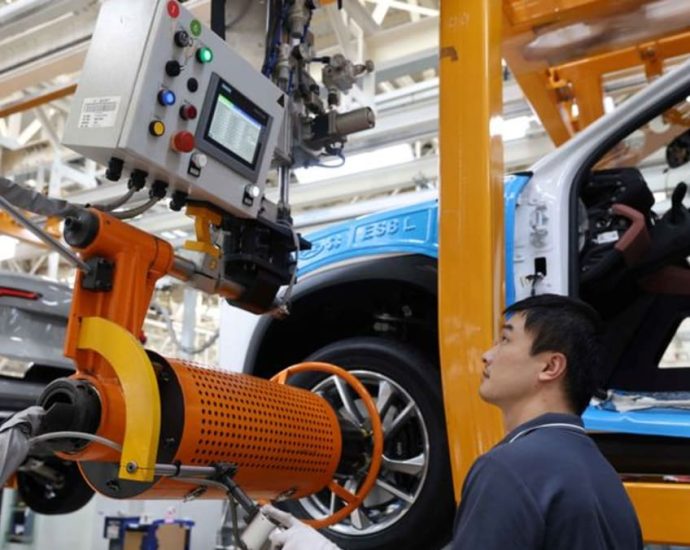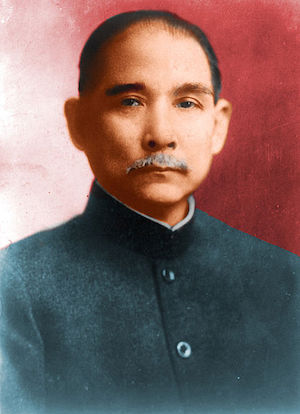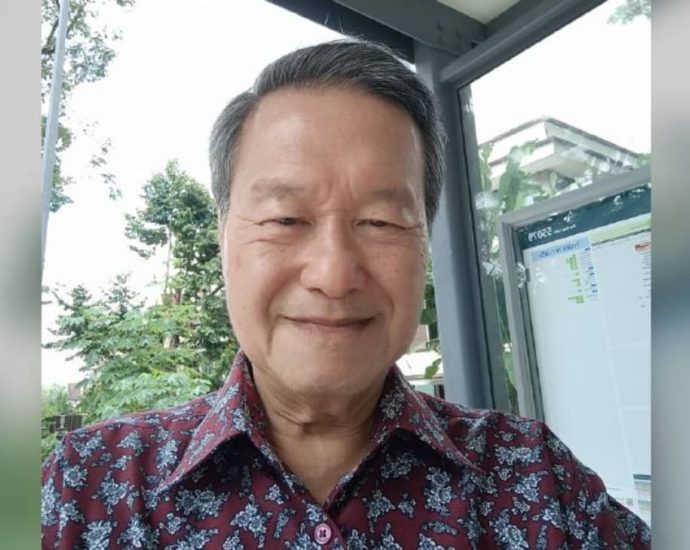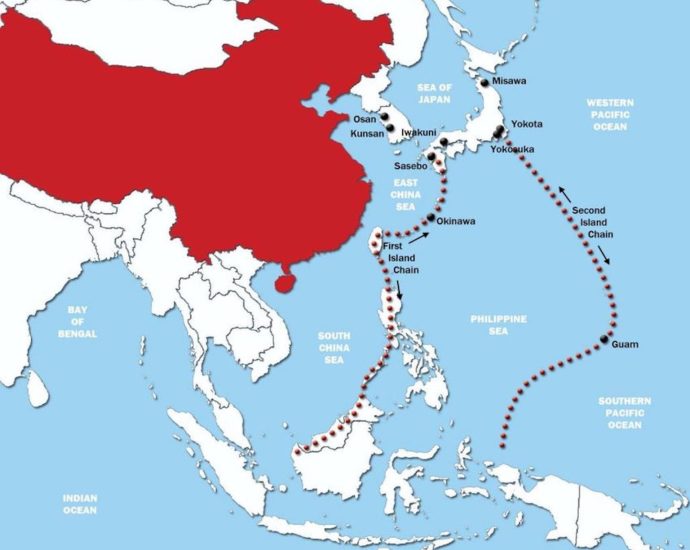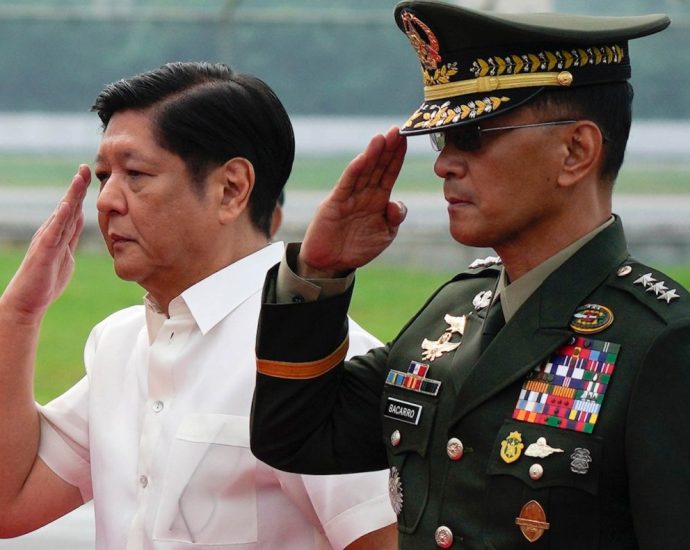How Chinaâs âold friendâ diplomacy may be hurting more than helping improve its US ties
When former United States secretary of state Henry Kissinger visited China earlier this month, it was a massive affair. Besides being treated to a lavish lunch by the Chinese government, the 100-year-old diplomatic heavyweight met Chinese Defence Minister Li Shangfu, who had declined earlier meetings with his American counterpart. KissingerContinue Reading
Extreme rain in Beijing after Typhoon Doksuri turns roads into rivers, kills two
BEIJING: In Beijing’s western suburbs, cars were swept away on Monday (Jul 31) as relentless rain since the weekend transformed roads into rivers, killing at least two and trapping hundreds, despite an overnight evacuation of tens of thousands from their homes. Hundreds of roads have become flooded in China’s capital, withContinue Reading
Most first-time voters understand President’s roles, less clear on relationship with government: CNA-TODAY survey
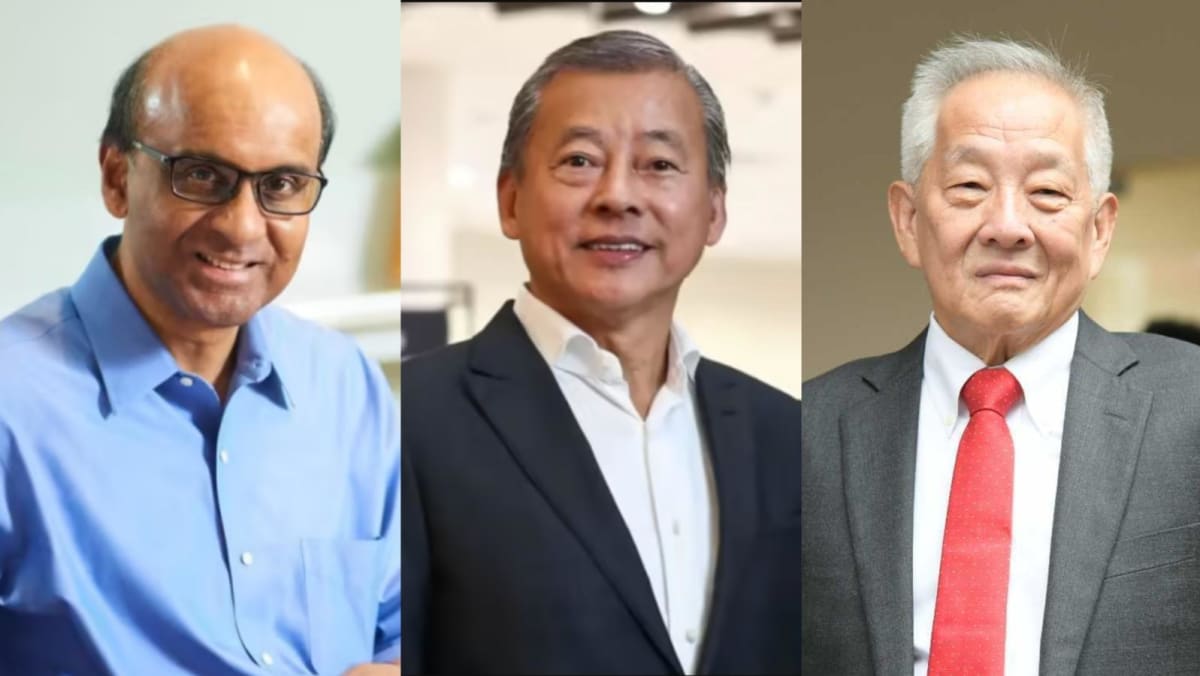
POLITICAL AFFILIATION
The issue of an elected President’s ties with political parties has been a divisive topic among the three presidential hopefuls since they announced their intention to run.
Mr Tharman, who has been a People’s Action Party (PAP) Member of Parliament since 2001, resigned from the ruling party and left politics on Jul 7.
When questioned about his independence at the official launch of his presidential bid on Jul 26, Mr Tharman cited the example of former President Ong Teng Cheong, who was a Cabinet minister and even chairman of the PAP for many years before he became Singapore’s head of state.
He emphasised his “independence of mind”, highlighting the difference between that and “independence from any past affiliation with a political party”.
In response to questions about Mr Tharman’s stand, fellow presidential hopeful Mr Goh said a day later that it is difficult for someone to become independent “overnight” after having been in Singapore’s political system for decades.
Mr Goh is best known as the founder of Harvey Norman Ossia, which distributes consumer electronics and furniture in Asia under the Australian brand.
Mr Ng, another presidential hopeful and the former chief investment officer of Singapore’s sovereign wealth fund GIC, has also spoken about his lack of political affiliations. He said Singapore needs a president who is “independent of any political party to safeguard the integrity of our institutions”.
From the survey questions on the President’s links with political parties, 65.4 per cent of respondents knew that the elected individual must not be a member of any political party.
About 56.3 per cent of respondents knew that a political party can endorse the elected President, while a higher 66.4 per cent knew that the elected President cannot endorse a political party.
Good awareness among Singaporeans about President’s roles but more public education needed on power dynamics: Analysts
PUBLIC EDUCATION NEEDED ON “SPECIFICITIES” Analysts generally agree that it is important to educate voters on these issues. Political observer from the Nanyang Technological University (NTU) Felix Tan said it is “definitely a concern” that Singaporeans do not have a strong awareness about the relationship between the President, the parliamentContinue Reading
Japanese eateries in China fear ruin as Fukushima water discharge looms
ALTERNATE SOURCES Seafood suppliers are also struggling. Wait times at Chinese ports have gone up from between two and seven days to around three weeks, a spokesman for a large seafood trader said, adding that the company plans to get around these restrictions by diverting shipments to a third country.Continue Reading
China’s factory, services sectors show weakness, need for stimulus
BEIJING: China’s manufacturing activity fell for a fourth straight month in July while the services and construction sectors teetered on the brink of contraction, official surveys showed on Monday (Jul 31), threatening growth prospects for the third quarter. Construction sector activity for July was its weakest since COVID-19-related workplace disruptionsContinue Reading
How the âMao suitâ changed the face of China
In the collection of the Australian War Memorial there is a photograph of four men in a North Korean prisoner of war camp, taken in the winter of 1952-3. Australian airman Ron Guthrie is in the group. He had been in captivity since August 1951.
More than 17,000 Australians took part in the Korean War, which began in June 1950 as a civil war between North and South Korea and quickly erupted into an international conflict involving China on the north side and the United States on the south. In Chinese, this war is known as the “resist America, support Korea” war.
On 27 July 1953, 70 years ago today, hostilities came to an indefinite halt with the signing of an armistice.

In this bitter, destructive and still unresolved conflict, one of the greatest challenges for both sides was how to deal with the weather. In the summer, men collapsed from the heat and humidity. Weapons became difficult to handle, blistering the hands.
Even worse were the winters. The men in this photo are wearing thickly padded clothes that would help them survive the extreme cold. A line in the 1970s TV series MASH sums up the likely weather conditions at the time: “The temperature is now two degrees below zero [°F]. Tonight’s forecast is cold, with a good chance of bad weather tomorrow.”
Australians had arrived in Korea unprepared for these conditions. They were initially helped out by the Americans and later, in due course, supplied with their own fit-for-purpose uniforms: a string vest, thick fleece underclothing, a heavy jersey, and windproof combat jacket and trousers under a fur lined parka. All this, together with a down sleeping bag, cost over £100, (around A$4000 in buying power today).
Clearly, the four POWs in the photo are not dressed in these made-in-Australia outfits. With the possible exception of the shoes, what they are wearing is not too different from ordinary dress worn by men in China at that time: a high-collared jacket with inset sleeves and five buttons paired with shapeless but nonetheless Western-style trousers, tailored at the crotch.
In a war dominated on the northern side by the Chinese People’s Volunteer Army, the similarities are not surprising. The prisoners are in fact wearing a variety of what foreigners would come to call a “Mao suit.” In Chinese it fits into a category of clothing called zhifu, or uniform.
Mass mobilization of sewing labour
What is a Mao suit? The term was first used to describe the relatively undifferentiated clothing of people in China during the Mao years – “all dressed in blue boiler suits” in the view of foreigners, although a closer look would show fine gradations in the clothing system. There was a large social distance between the well-tailored suit of fine wool worn by a high official and the roughly-made ensemble in homespun cotton worn by a man on the street.

The fitted, military-looking jacket of the Mao suit resonates both with the longer coat worn by India’s first prime minister Jawaharlal Nehru and with the stalinka, or Stalin tunic. These items of clothing were all products of global militarization in the 20th century.
The Chinese variant can be traced to a Japanese-influenced style of military jacket worn by “Father of the Republic” Sun Yat-sen, China’s most significant political leader before Mao Zedong.
Mao himself set the sartorial tone for Communist China by wearing a jacket in the Sun Yat-sen style when he announced the founding of the People’s Republic of China in 1949.

The altered appearance of the crowd in any Chinese town after 1949 was one of the most immediate effects of regime change. Both the Chinese long gown and the Western suit were abandoned. Clothing regulations for employees in the state sector established the Sun Yat-sen jacket or its poor relative, the “people’s jacket,” as standard dress.
Across China, tailors started cutting up old clothes to fashion these new-style garments. Much of this activity was undertaken while the Korean War was in progress.
For the civilian population, the provision of this new sort of clothing (literally xinyi or “new clothes”) was undertaken piecemeal, often by newly trained housewives given crash courses in the sewing and vocational schools that mushroomed across China in the early 1950s. For provisioning the armed forces, mass mobilization of labor was required.
Vast quantities of clothing were required very quickly to outfit the Chinese People’s Volunteer Army. In July 1950, normally a slack month in clothing production, four regional military administrations were ordered to supply 340,000 cotton padded uniforms and comparable or greater numbers of shoes, vests, and greatcoats. Gloves (cotton-padded mittens) and socks were needed in greater quantities again.
In the longer-term, skills acquired in the production of army uniforms (fitted garments with pockets, belt hooks, buttons, buttonholes and other novel features) would be applied to the mass production of civilian wear, which was constructed along similar lines.
The huge labor reserves available in China failed to avert a crisis in the supply of winter uniforms in the early months of the war. The Chinese clothing industry at that time was under-mechanized. Most clothes were still made at home or in the corner tailor shop. A sewing-machine industry was only just being developed. Cotton fields were only just being re-cultivated in wake of years of turmoil during the war against the Japanese (1937-1945) and the ensuing Civil War (1946-1949).
Accordingly, when the People’s Volunteer Army arrived in Korea, the soldiers were no better equipped than Australians. As summer turned to autumn, temperatures dropped precipitously. On the front, men cut up their bedding for protective clothing. In the winter, frostbite began to take its toll. Soldiers lost fingers, toes, noses and ears. In the decisive Battle of Chosin Reservoir, some 6,000 Americans and nearly 30,000 Chinese were immobilized by frostbite; 1,000 of them perished from the cold.
By the following spring, clothing production had been ramped up but supply lines were frequently affected by hostilities. Bombings in the Hwacheon Dam area in April 1951 took out a load of 280,000 summer-weight uniform jackets. Soldiers on the front were reduced to stripping their winter jackets of cotton wadding so that they had something serviceable to wear in the warmer weather.
Under these circumstances, clothing prisoners of war had low priority. What protective clothing they had at the time of capture was often taken from them. Cold was their constant companion.
After peace talks began in August 1951, conditions improved and the padded Mao suits of the photograph appear to have become standard issue. Thereafter, one of the main problems was living with lice, which secreted themselves in the seams. In the absence of a change of clothing, lice were almost impossible to eradicate.

Unpicking and re-fluffing
On both sides of the conflict, the punishing winter of 1950-51 concentrated the authorities’ attention on improving the quality of protective clothing. The technological gap between the US and China is apparent in the outcomes.
Footwear was a prime concern. For the Americans and their allies under the United Nations Command, leather combat boots such as worn in World War II had at first been thought sufficient. By August 1951, the US had come up with an airtight, insulated rubber boot, popularly known as the Mickey Mouse boot on account of its large toe. It did not eliminate the problem of frostbite but with frequent changes of woollen socks sharply reduced its incidence.
The Chinese, too, developed something more effective, with a larger toe, providing room for extra padding. Padded cloth socks were widely used and sewing socks for soldiers became a common domestic pastime.
Cotton was core to keeping warm. Insulation of hats, coats, trousers and mittens was provided by inserts of cotton fluff. When those are newly made up, the proportion of air to cotton provides good insulation in a garment. Over time, the cotton fluff becomes hard and matted, reducing its effectiveness against the cold. The clothes would need to be unpicked in the summer and the cotton refluffed for service the following winter, an arduous process that in China was a discrete cottage industry.
Fortunately for Guthrie and the other Australian prisoners, this would be their last winter in a POW camp. The armistice was signed in the summer of 1953. An exchange of sick and injured POWs had already taken place in April. The “Big Switch,” entailing an exchange of thousands of POWs from each side, followed in September. It was early autumn. The padded winter “Mao suit” had long since been discarded in favour of its summer equivalent – the plain, blue, high-collared jacket and trousers worn all over China by ordinary working men.
Photographed on release, Guthrie and his companions wear their clothes casually – half-buttoned up, collars gaping over white singlets, caps worn jauntily or backwards. They would shortly change these clothes for their service uniforms. Twenty-nine of the 30 Australians who became POWs returned home, a remarkable survival rate.

Travelling in the opposite direction to Guthrie was a political officer of the People’s Volunteer Army, Xie Zhiqi. At the end of the war the majority of POWs from the People’s Volunteer Army chose to go to Taiwan. Xie was one of the minority who went back to China.
All repatriates to China were interned on arrival and subjected to investigation. Xie was accused of having participated in reactionary activities during his time as POW. Expelled from the Chinese Youth League (a Communist Party organization) and discharged from the People’s Liberation Army, he had to surrender his army uniform.
He spent the rest of his working life, including seven years of it in a labor camp, wearing the plain blue trousers and high-collared jacket that is now indelibly associated with Mao’s China.
Antonia Finnane is the author of, most recently, How to Make a Mao Suit: Clothing the People of Communist China 1949-1976 (Cambridge University Press, 2023). She is a professor (honorary) at The University of Melbourne.
This article is republished from The Conversation under a Creative Commons license. Read the original article.
Former candidate Tan Kin Lian applies for eligibility certificate for 2023 Presidential Election

Potential candidates have been able to apply for a Certificate of Eligibility since Jun 13 – the first step in order to enter the presidential race. Prospective candidates must also submit a community declaration.
To qualify, the prospective candidate must have held a senior public office or helmed a company that has at least S$500 million (US$370 million) in shareholders’ equity for at least three years.
The contender must also be a Singapore citizen, be at least 45 years old on Nomination Day and not belong to any political party.
FORMER PRESIDENTIAL CANDIDATE
In 2011, Mr Tan Kin Lian competed against former deputy prime minister Dr Tony Tan, Progress Singapore Party founder Tan Cheng Bock and opposition politician Tan Jee Say. Dr Tan won the final vote in the 2011 polls, gaining 745,693 (35.2 per cent) of the votes.
Mr Tan won 104,085 (4.91 per cent) of the total 2,274,773 votes and lost his deposit for failing to garner more than one-eighth of the total number of votes polled in the election.
Mr Tan became Chief Executive Officer of NTUC Income in 1977, holding the position for 30 years until he left in April 2007.
After he left NTUC Income, Mr Tan started a business in computer software and has also travelled regularly to provide insurance consultancy in Indonesia.
According to the Straits Times, Mr Tan had served as the People’s Action Party’s branch secretary at Marine Parade in the 1970s.
He was picked by former senior minister Goh Chok Tong – then a Member of Parliament – to test a pilot scheme for setting up block committees, now known as residents’ committees.
Mr Tan left the party in 2008, after being in Marine Parade GRC for 10 years before remaining largely inactive for 20 years when he moved to Yio Chu Kang.
US unveils island launchers for China containment
“US Long-Range Fires Launcher complements OpFires and Typhon in implementing its missile wall strategy versus China.”
The US Marine Corps (USMC) has just unveiled its new land-based cruise missile launcher, the latest addition to several similar systems promising dispersed, survivable firepower in its “missile wall” containment strategy against China.
This month, The Warzone reported that the USMC had unveiled the Long-Range Fires Launcher, an uncrewed 4×4 launch vehicle based on the Remotely Operated Ground Unit for Expeditionary-Fires (ROGUE-Fires) vehicle for the land-based Tomahawk cruise missile that the service aims to field.
The source notes that the USMC’s first Long Range Missile (LMSL) battery had already been formally activated this year, with the service hoping to have a multi-battery LMSL battalion with an unspecified number of launchers by 2030.
The Warzone notes that the Long-Range Fires Launcher can hold just one Tomahawk missile at a time, unlike the Navy-Marine Expeditionary Ship Interdiction System (NMESIS), which can fit two Naval Strike Missiles. The source notes both are mounted on the ROGUE-Fires uncrewed Joint Light Tactical Vehicle (JLTV) operated remotely by ground personnel.
The USMC’s development of the Long-Range Fires launcher may address a mobility gap associated with the truck-towed OpFires and Typhon. Naval News notes that the latter two launchers cannot fit in a C-130 cargo plane, whereas they could if mounted on the USMC’s smaller Medium Tactical Vehicle Replacement (MTVR). That could make their rapid deployment possible on remote Pacific islands.
In July 2022, Asia Times reported about the USMC Operational Fires (OpFires) hypersonic weapon test that month. OpFires features a high degree of interoperability with US Army systems, with the US Defense Advanced Research Projects Agency (DARPA) noting that a USMC logistics truck with the Palletized Load System (PLS) launched the OpFires missile, making any vehicle in the US inventory with the system a potential launcher.
DARPA also said the OpFires test used US Army artillery and fire control systems for launch, enabling inter-service joint operations, reinforcing systems capability and simplifying logistics.
In terms of system components, Naval News notes that the OpFires can carry various payloads, with the system consisting of missiles, canisters, and launchers sized to fit on the US Army’s PLS and USMC’s Logistic Vehicle System Replacement (LVSR) units. The source also says three OpFires missiles can fit on a US military 10×10 truck and that the US Marine Corps is experimenting with the Tactical Tomahawk fired from a trailer-mounted Mk 41 VLS.
Previously, in December 2022, Asia Times reported about the US Army’s acquisition of its first four Typhon missile launchers as part of its mid-range capability (MRC) program to fill in its requirement for long-range fires in the Pacific theater. The Typhon is designed to fire Standard SM-6 or Tomahawk missiles between 500 and 1,800 kilometers, which are between the US Army’s Precision Strike Missile (PSM) and the Long-Range Hypersonic Weapon (LRHW), which have respective ranges of 482 and 2,776 kilometers.
The latest Standard SM-6 Block IB features a redesigned body and larger rocket motor, giving it improved anti-air and anti-missile capabilities, and a possible secondary land attack function, while the latest Tomahawk Block V features new communications, anti-ship capability, and multi-effect warheads. Each Typhon unit consists of an operations center, four Mk 41-derived vertical launch system (VLS) launchers towed by M983A4 tractor trucks, and associated reloading and ground equipment.
Land-based missile launchers may have advantages over their ship-based counterparts, including increased survivability and effectiveness for less cost. They can also constantly present in contested areas, providing tactical and operational cover for US and allied forces. Also, attacking ISland-based missile launchers on its allies’ territories can significantly escalate hostilities.
Those advantages may tie into the 2021 US Marine Corps Concept for Stand-In Forces (SIF), which defines SIFs as “small but lethal, low signature, mobile, relatively simple to maintain and sustain forces designed to operate across the competition continuum within a contested area as the leading edge of a maritime defense-in-depth to disrupt the plans of a potential or actual adversary intentionally.” The document also states that SIFs conduct sea denial operations to support fleet operations near maritime chokepoints, using organic sensors and weapons to complete kill webs.
Those systems also tie in with the US New Pacific Deterrence Initiative, which USNI News notes will involve ground forces with long-range weapons in the First Island Chain to create temporary bubbles of localized air and maritime superiority, enabling maneuver by amphibious forces to create temporal and geographic uncertainty to impose costs and conduct forcible entry operations.

At the strategic level, the US Long-Range Fires, OpFires, and Typhon programs may be part of a larger “missile wall” containment strategy against China. The simultaneous deployment of US and Chinese anti-access/area denial capabilities near contested waterways and airspace can result in neither side enjoying the freedom of maneuver over those areas, maintaining a tense but stable military balance in the Pacific.
However, a 2022 RAND study notes that the strategy may fail since the US may need help finding an ideal partner for these Ground-Based Intermediate-Range Missiles (GBIRM). It states that as long as Thailand has a military-backed government that pursues closer ties with China, Thailand will not want to host US GBIRMs.
While the Philippines’ alliance with the US has undergone a significant reset under the Marcos Jr. administration, that has not alleviated the former’s reluctance to host permanent US bases, weak territorial defense capability, and vulnerability to naval blockade. Such makes US deployments of GBIRMs unlikely in the Philippines.
The RAND study notes that South Korea is not an ideal base for US ground-based long-range missiles due to its vulnerability to Chinese economic pressure, disagreements with the US over operational control of South Korea’s military, and South Korea’s doubts over US security guarantees.
While the study notes Australia and the US’ strong alliance, the former’s distance from Taiwan and the South China Sea, coupled with its reluctance to host permanent US bases, rules it out as an ideal GBIRM basing location.
The study notes that Japan may be an ideal partner for US GBIRM deployments, citing its strong alliance with the US and willingness to bolster its defense capabilities. Although it says that Japan may be reluctant to host US GBIRMs, as they could be nuclear-armed, Japan may be willing to host conventionally-armed missiles. It also says that the US approach to Japan that would most likely succeed would be to help the latter have its arsenal of ground-based anti-ship missiles.
Marcosâs military pension, US cooperation dilemma

Historically, the Philippine military played a crucial role in the toppling of two powerful presidents. And that helps to explain the sensitivity of pension reform moves currently afoot.
In his secondsState of the nation address, Philippine President Ferdinand Marcos Jr hailed the country’s “sound” economic fundamentals despite an uptick in inflation over the past year.
Eager to press ahead with a massive infrastructure initiative, however, he has called on lawmakers to institute new tax measures under the “medium-term fiscal framework,” including value-added tax on the booming digital-economy sector, expanded motor-vehicle user’s charges, and new taxes on the mining sector.
The government expects to raise between 12.4 billion and 15.8 billion pesos (US$$220 million to $300 million) in additional resources under the first year of the framework’s implementation.
The prospect of new taxes amid historic inflation rates didn’t go down well among the Filipino populace, who are still reeling from one of the highest living costs in Southeast Asia.
But the president faces an even more sensitive and highly consequential fiscal reform challenge, namely the proposed reform of the Philippine military and uniformed personnel pension, which is has raised fears of a backlash on the part of elements of the country’s powerful security forces.
Confronting the prospect of a fiscal crisis in coming years, the Marcos administration is pushing for “self-regenerating” pension plans for both the Armed Forces of the Philippines and the Philippine National Police.
Marcos’s top technocrats have warned that the status quo is unsustainable, since the pension’s annual payouts could reach the 1-trillion-peso mark by 2035 from 213 billion pesos this year.
In his address, Marcos played down the challenge, promising a soft landing on the issue. Given the Philippines’ long history of coups, however, Marcos needs to keep the military on his side.
And this only raises the stakes for his military pivot to the US, a key source of training and equipment for the armed forces. Reforming the pension is inextricably linked to ongoing plans to expand Philippine-US cooperation under the Enhanced Defense Cooperation Agreement.
Duterte’s dilemma
History offers clear warnings to proceed carefully. To start with, the Ferdinand Marcos Sr regime collapsed in 1986 after a popular coup by his top henchmen, former defense minister Juan Ponce Enrile and military chief Fidel Ramos.
Although mainstream narratives emphasize the “People Power” protests led by the late president Corazon “Cory” Aquino, historians often speak of a “civilian-backed coup” to describe the chain of events that culminated in the overthrow of the Marcos dictatorship.
In 2001, populist president Joseph Estrada, a Marcos loyalist, was similarly toppled by another round of People Power protests. But the crucial factor was the armed forces’ top brass’s withdrawal of support for the embattled president amid escalating popular opposition.
Over the succeeding years, president Gloria Macapagal Arroyo also faced multiple coup attempts amid chronic corruption and election anomalies, underscoring the influence of the powerful military in shaping Philippine politics.
A self-described “socialist,” with an avowedly pro-China foreign-policy orientation, president Rodrigo Duterte wasted no time to win over the country’s armed forces. In his first few months in office, he personally visited as many 14 military camps, lavishing praise and promising expanded benefits to soldiers and generals.
Soon, he appointed as many as 60 senior generals and senior officers from the military and security services to cabinet and sub-cabinet positions, making his administration the most militarized in recent memory.
On multiple occasions, he also revisited his peace negotiations with communist rebels in deference to his generals. He also rescinded his earlier threat to boot out American troops from the Philippines.
As the former president put it in a public address, “the military would oust me” if he fully ignored their concerns. By 2018, Duterte tried to soften the blow of his China-leaning foreign policy by doubling entry-level police and military personnel’s salary, while boosting all ranking officers’ wages by 72%.
Meanwhile, Duterte also promoted a whole host of friendly generals, while appointing a succession of newly-retired military chiefs to prized civilian positions. The military also benefited from the acquisition of modern weapons amid a billion-dollar modernization program.
What the military wants
In fairness, the armed forces remained broadly professional, maintaining their commitment to defending the country’s sovereign waters amid growing Chinese encroachments throughout Duterte’s presidency.
But Duterte’s charm offensive also largely explains the absence of any serious coup attempts throughout his extremely controversial term in office.
The upshot of the populist president’s policies, however, was a fiscal time bomb, as the government lavished benefits on security personnel in an unsustainable fashion.
Just as the Duterte administration increased wages and benefits, it kept the military’s pension system highly liberal, whereby uniformed personnel are not required to make contributions and retired personnel would receive pension increases whenever active servicemen enjoyed expanded benefits.
Earlier this year, Philippine Finance Secretary Benjamin Diokno warned that the military pension system was not “not sustainable,” warning that “if this goes on, there will be a fiscal collapse.” In response, former acting defense chief Carlito Galvez warned that any reform of the pension system could force the premature retirement of 70-to-80% of enlisted personnel.
A few months later, Marcos appointed Harvard-trained lawyer and longtime businessman Gilberto “Gibo” Teodoro as the new defense secretary.
His first marching orders to the new defense chief, who also served in the same capacity during the Arroyo administration, was to oversee the rationalization of the military’s pension system by reducing monthly pension for retirees, raising retirement age and/or instituting mandatory contributions from soldiers.
Recognizing the sensitivity of the issue, Teodoro promised “minimal” financial burden on the uniformed services.
“We want a self-sustained pension system,” he said, “but it needs a couple of years to load it up in order for it to be self-sustaining.” When asked about the impact on morale of the armed forces, Teodoro emphasized the need to “appeal to their patriotism.”
As the Marcos administration proceeds to rationalize its historically generous pension system for the military, it will inevitably have to consider the armed forces’ strategic preferences. In particular, the Philippine military supports expanded defense ties with the Pentagon, a key source of training, equipment and aid over the past half-century.
Eager to avoid confrontation with China and its proxies, Marcos has repeatedly equivocated on the exact nature of the agreement with the US. For the military, however, the defense pact is a great boon, thus their preference for a maximalist version of the agreement which expedites modernization of Philippine military and joint preparations with the Pentagon for any potential contingencies in either Taiwan or the South China Sea.
“If we are to protect our sovereignty and territorial integrity, including the protection of maritime resources that should be enjoyed by our people, we need a 360-degree protection capability,” Colonel Medel Aguilar, armed forces spokesman, told the media this year.
“Aside from equipment, modernization also means getting facilities – such as runways, barracks for our soldiers, and where to store equipment during times of emergency,” the armed forces’ spokesman added.

